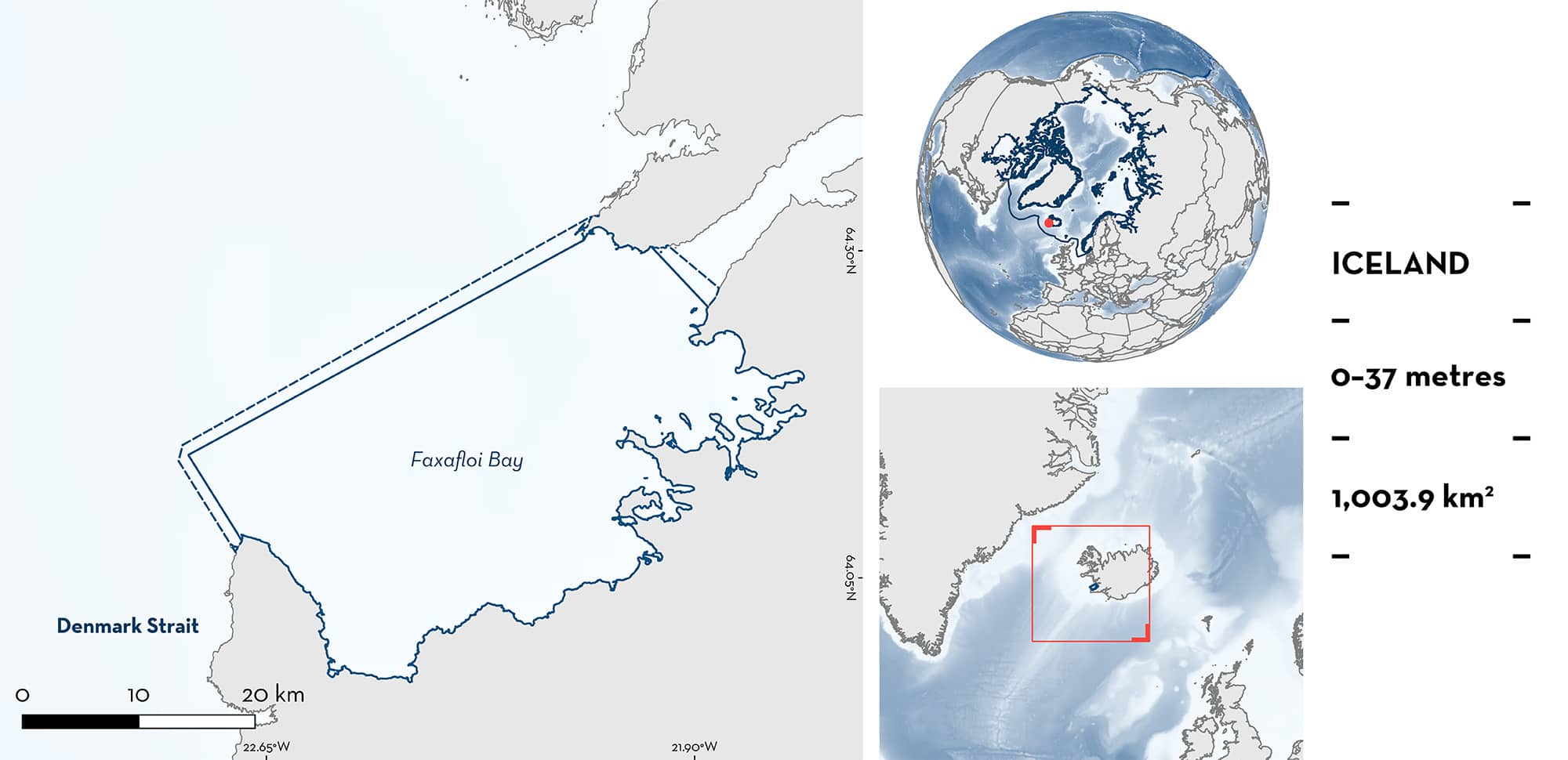ISRA FACTSHEETS
ISRA FACTSHEETS
POLAR WATERS REGION
Faxaflói Bay
Summary
Faxaflói Bay is located on the southwest coast of Iceland. It is the largest bay in Iceland, and is influenced by boreal spring warming, freshwater input, and upwelling of nutrient rich deep water to the surface. The area is also characterised by seasonal blooms in phytoplankton. Within this area there are: threatened species and feeding areas (Basking Shark Cetorhinus maximus).
Download factsheet
Faxaflói Bay
DESCRIPTION OF HABITAT
Faxaflói Bay is located on the southwest coast of Iceland, near Reykjavik. It is the largest bay in Iceland. The area includes several small islands (Akurey, Engey, Lundey, Þerney, and Viðey).
The area remains relatively ice-free year-round. It is influenced by freshwater runoff, variable wind action, and boreal spring warming. This results in seasonal blooms in chlorophyll-a in spring, which begin close to the shore (Astthorsson & Gislason 1999). The area is influenced by upwelling from the North Atlantic Current which transports nutrients from deep waters to the surface off the continental shelf (Special Tours 2020).
This Important Shark and Ray Area is pelagic and delineated from inshore and surface waters (0 m) to 37 m based on the bathymetry of the area.
CRITERION A
VULNERABILITY
One Qualifying Species considered threatened with extinction according to the IUCN Red List of Threatened Species regularly occurs in the area. This is the Endangered Basking Shark (Rigby et al. 2021).
CRITERION C
SUB-CRITERION C2 – FEEDING AREAS
Faxaflói Bay is an important feeding area for one shark species.
Basking Sharks are regular, seasonal, and annual visitors to the area. A compilation of data for the period 2013–2024 highlights records from a total of 23 individuals in the area (Elding Research unpubl. data. 2024). All were solitary individuals directly observed in the water by a network of observers and represent the largest contemporary cluster of Basking Shark records in Iceland. Individuals measured up to 800 cm total length and were mostly observed in summer (June to August) (Elding Research unpubl. data. 2024).
All sightings occurred near the surface of the water (Elding Research unpubl. data. 2024), with feeding behaviour being photographed, video recorded, and reported. Further information is available for a subset of 18 Basking Shark observations in this area (Elding Research unpubl. data 2024). These were observed in 2014 (n = 3), 2016 (n = 6), 2018 (n = 1), and 2019 (n = 8). All individuals were solitary apart from two which were observed together in 2016. Most observations were made in August (n = 13) with the others being made in September (n = 4) and July (n = 1) (Elding Research unpubl. data 2024). This could indicate seasonality in feeding behaviour. Upwelling in this bay transports nutrients to surface waters and enhances productivity (Special Tours 2020). Peaks in chlorophyll-a concentration in the spring (Astthorsson & Gislason 1999) presents a foraging opportunity for Basking Sharks. This area has particular importance as the regular and predictable observations of Basking Sharks could reflect the local recovery of a population which has been significantly affected by longstanding fishing activities (ICES 2019).
Download factsheet
SUBMIT A REQUEST
ISRA SPATIAL LAYER REQUEST
To make a request to download the ISRA Layer in either a GIS compatible Shapefile (.shp) or Google Earth compatible Keyhole Markup Language Zipped file (.kmz) please complete the following form. We will review your request and send the download details to you. We will endeavor to send you the requested files as soon as we can. However, please note that this is not an automated process, and before requests are responded to, they undergo internal review and authorization. As such, requests normally take 5–10 working days to process.
Should you have questions about the data or process, please do not hesitate to contact us.


